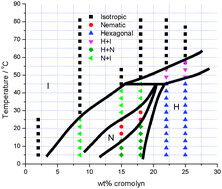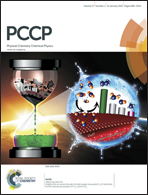Deriving binary phase diagrams for chromonic materials in water mixtures via fluorescence spectroscopy: cromolyn and water
Abstract
We report here the first example of a new and novel method of determining the binary temperature–composition phase diagram of a chromonic material in water using its intrinsic fluorescence. Disodium cromoglycate, or cromolyn, is an anti-allergy medicine representative of a class of compounds known as the chromonics. We have discovered that cromolyn's fluorescence is very sensitive to the polarity, hence structure, of the phase it exhibits. The fluorescence signal shifts its wavelength maximum and its shape depending on whether the cromolyn is a single phase or in coexisting phases. Since the signal due to individual phases can be identified, the fluorescence signal can reveal the temperature-induced transitions between single phase and phase coexistence regions. By studying such fluorescence data for different compositions, an isobaric temperature–composition phase diagram may be constructed. We present here a phase diagram derived from fluorescence studies that is in agreement with previous determinations using other techniques. Our results suggest that the binary phase diagrams of other intrinsically fluorescent chromonic materials, such as perylene monoimide and bisimide derivatives used in organic optoelectronic devices, solar cells, and light-emitting diodes, can be studied in water using an analogous fluorescence approach.


 Please wait while we load your content...
Please wait while we load your content...